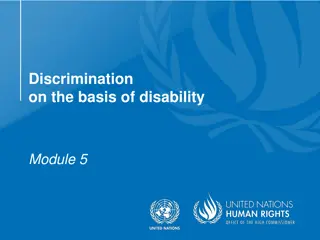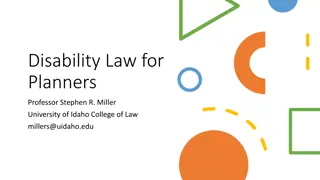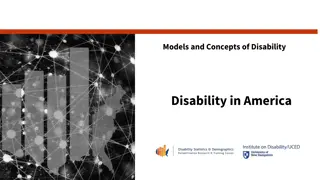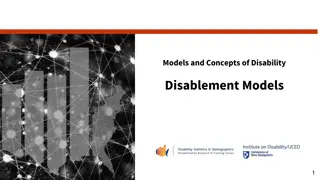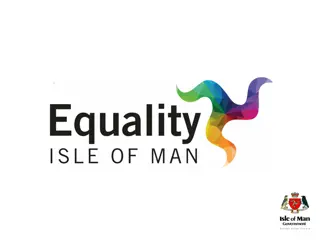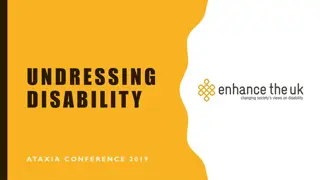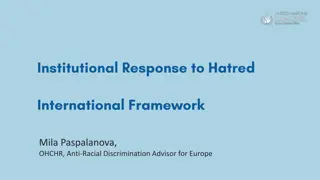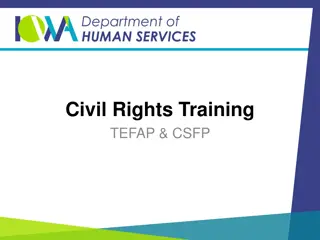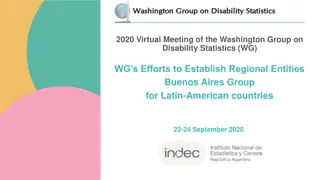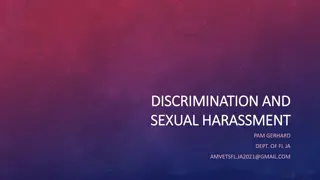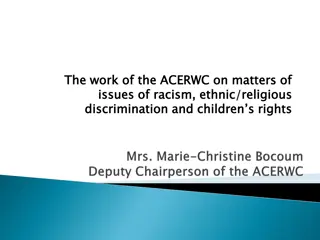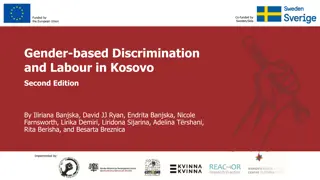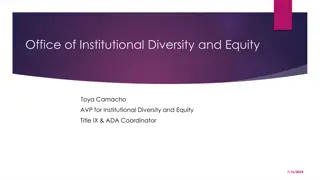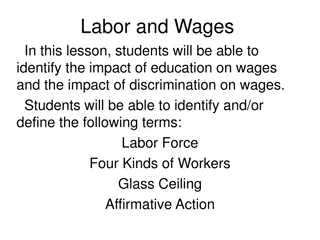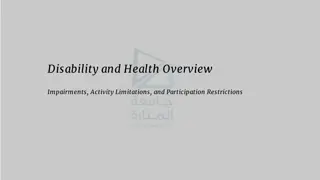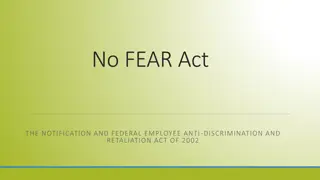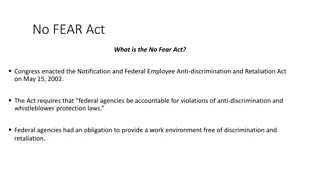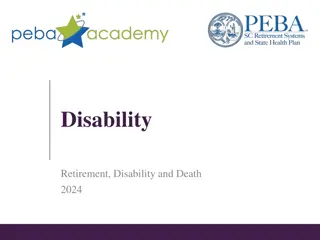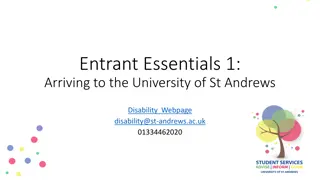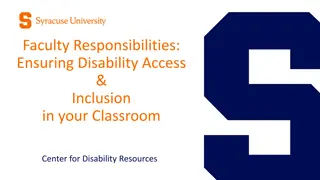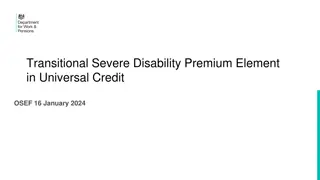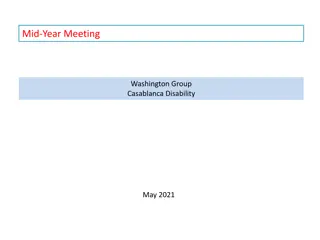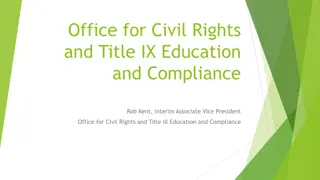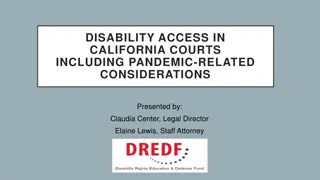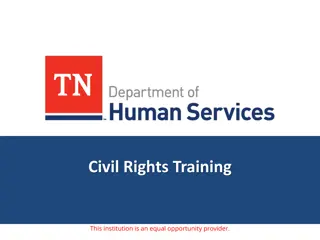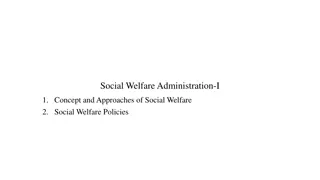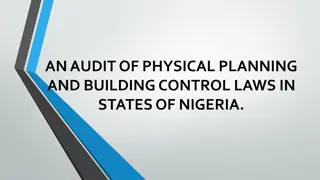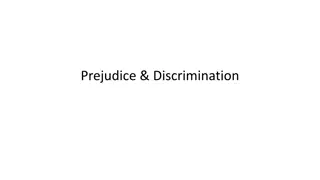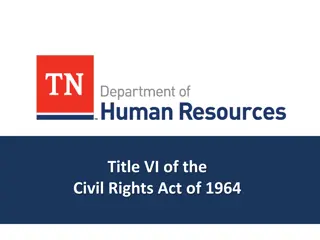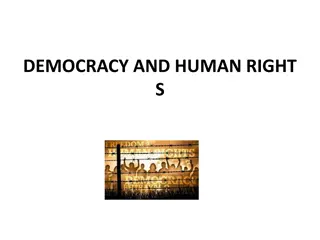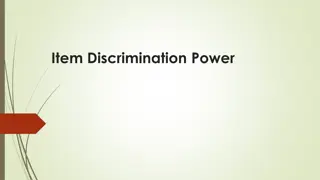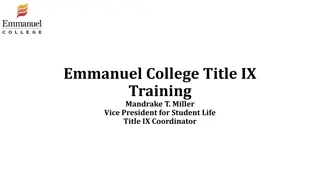Understanding Disability Discrimination Laws in Education
Comprehensive overview of Disability Discrimination Act 1992 (Cth), Disability Standards for Education 2005 (Cth), and the legal framework prohibiting discrimination against students with disabilities. Exploring direct and indirect discrimination, limitations of the DDA, and examples of less favorable treatment. Learn about students' rights, potential legal actions, and the importance of accommodation adjustments in tertiary education.
Download Presentation

Please find below an Image/Link to download the presentation.
The content on the website is provided AS IS for your information and personal use only. It may not be sold, licensed, or shared on other websites without obtaining consent from the author. Download presentation by click this link. If you encounter any issues during the download, it is possible that the publisher has removed the file from their server.
E N D
Presentation Transcript
Dr Elizabeth Dickson Law School QUT e.dickson@qut.edu.au
Refresher on Disability Discrimination Act 1992 (Cth) (DDA) Limitations of DDA Refresher on Disability Standards for Education 2005 (Cth) (DSE) Tertiary education issues disclosure Inherent requirements Interrupted course progression disability related challenging behaviour Questions I know a bit about the law but not much about specific adjustments
Federal and State legislation prohibits discrimination by education authorities and institutions against students with disability Disability Discrimination Act 1992 (Cth) ( DDA ) Anti-Discrimination Act 1991 (Qld) Students may sue under either Act education institution has no say If a complaint is accepted Conciliation Court (Federal) or Tribunal (State) hearing, if conciliation fails Focus today DDA
Two varieties of discrimination Direct Indirect Other actions also prohibited Harassment Victimisation
Less favourable treatment of the complainant. Whether treatment is less favourable is determined by comparing the treatment of the complainant with the treatment of another without the complainant's disability in circumstances which are not materially different . See, eg, DDA s 5 Limit: proof of unjustifiable hardship on the education provider will defeat a claim of direct discrimination
Classic example of less favourable treatment : student with disability not enrolled/excluded student without disability enrolled/not excluded See, for example, Hills Grammar School v Human Rights and Equal Opportunity Commission (mobility impairment)
Facially neutral or hidden or institutional discrimination. Occurs when treating people in the same way has a discriminatory impact on those with a protected attribute. Condition placed upon the inclusion of the person with disability [usually inferred from the facts]; and The person with disability cannot comply with the condition; and The requirement or condition has, or is likely to have, the effect of disadvantaging persons with the disability; and The condition is not reasonable Limit: proof that the condition is reasonable will defeat a claim of indirect discrimination
Classic example This institution is accessible only by steps A person with a mobility impairment cannot use steps Condition will disadvantage the person with the disability impairment May or may not be reasonable depending on the circumstances c/f Kinsela v Queensland University of Technology (mobility impairment)
DDA s 5(2) For the purposes of this Act, a person (the discriminator discriminates on the ground of a disability of the aggrieved person if: (a) the discriminator does not make, or proposes not to make, reasonable adjustments for the person; and (b) the failure to make the reasonable adjustments has, or would have, the effect that the aggrieved person is, because of the disability, treated less favourably than a person without the disability would be treated in circumstances that are not materially different. discriminator ) also aggrieved person ) discriminates against another person (the aggrieved person DDA s 4 "reasonable adjustment" person is a reasonable adjustment adjustment would impose an unjustifiable hardship on the person. "reasonable adjustment" : an adjustment to be made by a reasonable adjustment unless making the
DDA s 6(2) For the purposes of this Act, a person (the discriminator) also discriminates against another person (the aggrieved person) on the ground of a disability of the aggrieved person if: (a) the discriminator requires, or proposes to require, the aggrieved person to comply with a requirement or condition; and (b) because of the disability, the aggrieved person would comply, or would be able to comply, with the requirement or condition only if the discriminator made reasonable adjustments for the person, but the discriminator does not do so or proposes not to do so; and (c) the failure to make reasonable adjustments has, or is likely to have, the effect of disadvantaging persons with the disability.
Even before these amendments in a practical sense adjustments were sometimes necessary to avoid discrimination: ramp access for people with mobility impairment assistive technology to support access to learning extensions on assignments
Sklavos v Australian College of Dermatologists (2017, DDA) Failure to make reasonable adjustment must be because of disability? DDA s 5(2) For the purposes of this Act, a person (the discriminator ) also discriminates against another person (the aggrieved person ) on the ground of a disability of the aggrieved person if: (a) the discriminator does not make, or proposes not to make, reasonable adjustments for the person; and (b) the failure to make the reasonable adjustments has, or would have, the effect that the aggrieved person is, because of the disability, treated less favourably than a person without the disability would be treated in circumstances that are not materially different. Is a failure to make reasonable adjustment ever BECAUSE OF the disability?
Sklavos again If the term is reasonable (s 6(3)), consideration of reasonable adjustment is redundant As noted, above, however avoiding indirect discrimination may require adjustment Failure to adjust may in practice mean that an unreasonable condition is imposed 1. You have to be able to climb steps to access the building You install a ramp the condition is removed No discrimination 2. You have to be able to climb steps to access the building You don t install a ramp The condition remains Not reasonable? discrimination
Disability Standards for Education 2005 enacted under the authority of DDA s 31. Compliance with the Standards amounts to compliance with the DDA: s 34 Theoretical protection against being sued But create a separate cause of action Failure to make reasonable adjustment can be alleged in this context Remedy for failure? Possibly Sklavos
Cover a number of key aspects of the delivery of education services: enrolment (Part 4) participation (Part 5) curriculum development, accreditation and delivery (Part 6) student support services (Part 7) elimination of harassment and victimization (Part 8)
For each aspect, the Standards set out student rights, consistent with the rights of the rest of the community the legal obligation of education providers to take reasonable steps to ensure students with disabilities enjoy those rights on the same basis as other students measures of compliance The overarching obligation is to make reasonable adjustment In some cases, students with disabilities will not be able to participate on the same basis as other students if all students are treated in the same way, or if all students with disabilities are treated in the same way (Standards 2.2(3))
Case alleging discrimination and breach of the Disability Standards (dyslexia, ADHD, ASD) The Disability Standards require no more of a government agency such as the Department than that, where necessary, it be alert to the need to adjust its normal practices when dealing with a disabled student; to consider, in [1*] consultation with the student or his or her parents, [2*] what reasonable adjustments to normal practices should be made to assist the student, and then to [3*] decide whether a particular adjustment is necessary and, if so, [*4] to implement it. [para 274] * my numbers
Not defined in Standards (repeatedly highlighted as problematic in Reviews) Walker: [The Standards] require a school to consult a student or his or her parents about prescribed matters. They do not, however, require that such consultation take any particular form or occur at any particular time. Those involved may meet formally or informally. Discussions can be instigated by either the school or the parents. Consultation may occur in face-to-face meetings, in the course of telephone conversations or in exchanges of correspondence. [284]
Disability services staff; access plan Must occur upon (before?) enrolment And for the duration of the enrolment Consider new information Assess whether adjustments are working Consider whether different adjustments are needed Schedule regular consultation Keep cool keep good notes Keep on file Consultation with academic staff??
Walker: Once consultation has occurred it is for the school to determine whether any adjustment is necessary in order to ensure that the student is able, in a meaningful way, to participate in the programmes offered by the school. The school is not bound, in making these decisions, by the opinions or wishes of professional advisers or parents. The school is also required to determine whether any reasonable adjustment is possible in order to further the prescribed aims. There may, therefore, be cases in which an adjustment is necessary but no reasonable adjustment is able to be identified which will ensure that the objectives contained in the relevant Disability Standards are achieved. [para 284]
An adjustment will not be required if it is not reasonable if it would cause unjustifiable hardship [Standards 10.2] if it would be inconsistent with an act authorized by law [Standards 10.3] (eg, restraining order) if it would jeopardize the health of a student with disabilities or the health of other students [Standards 10.4] (eg, infectious disease)
It is reasonable taking into account Disability Views of student Effect on student Effect on others Cost and benefits And, it does not impose unjustifiable hardship Benefit/detriment to anyone concerned Effect of disability Financial circumstances of provider of service More on unjustifiable hardship later
Some students are reluctant to disclose disability to the education institution This is problematic if disability then affects study and a delayed disclosure is made Early case law suggested that it was possible to discriminate against someone on the ground of an unknown disability, for example by failing to make adjustments for that disability: X v McHugh (1994, DDA) Now, the test for causation requires disability to be the true basis of the discriminatory treatment (Purvis v NSW (2004, DDA) and it is difficult to prove that if the discriminator does not know about the disability Note that if the disability is disclosed to a staff member of the education institution, rather than through a formal disclosure process, that might amount to constructive knowledge by the institution Do big education institutions like universities have systems in place to account for this? Should academics be better trained to respond to disability? Is there a legislative expectation of adjustment outside the disability advisor/disability access plan framework
See DSE s 3.7 The education provider must take reasonable steps to ensure that any adjustment required to be made is made within a reasonable time . Whether the time is reasonable depends, in particular, on whether and when the student, or his or her associate, has provided...in a timely way, any relevant information in the possession of the student or associate about how the disability affects the student in relation to education or training... See Sluggett v Flinders University (2000, DDA); Hinchliffe v University of Sydney (2004, DDA)
DSE 3.4(3): In assessing whether an adjustment to the course of the course [sic] or program in which the student is enrolled, or proposes to be enrolled, is reasonable, the provider is entitled to maintain the academic requirements of the course or program, and other requirements or components that are inherent in or essential to its nature. Note In providing for students with disabilities, a provider may continue to ensure the integrity of its courses or programs and assessment requirements and processes, so that those on whom it confers an award can present themselves as having the appropriate knowledge, experience and expertise implicit in the holding of that particular award Brackenreg v QUT (1999, Qld legislation) even when consideration was given to the complainant by the respondent for her disabilities, such as giving her extra time to complete exams, extensions of time in handing in assignments and by giving her conceded passes on numerous occasions after considering her circumstances, she still demonstrated an inability to satisfactorily complete a law degree to the standard required by the respondent. There is no obligation on the respondent to pass a student just because they have a disability. Their obligation is to reasonably make available such special services or facilities which may be necessary to enable a student with disabilities to be able to undertake their studies.
Andreopoulos v University of Canberra (2020, ACT legislation) Reasonable adjustments are intended to provide a student with a disability the opportunity learning experience, on the same basis as a student without a disability. Reasonable adjustments do not require the University to provide a bespoke learning experience. The maintenance of academic integrity is fundamental. Reasonable adjustments do not guarantee that a student with a disability will necessarily be able to cope with the course or assessment requirements, particularly in a clinically focused course such as physiotherapy. Nor are reasonable adjustments intended to be a substitute for adequate practice, study and preparation for Viva exams that are designed deliberately to simulate clinical practice and prepare students for clinical placements, where patient safety is a paramount consideration [para 265]. opportunity to participate in a course, program or
Useful if makes academics unpack what is actually inherent? A double edged sword? May inform student of expectations implicit in course and allow staff to consider adjustments to support meeting those requirements May be used to refuse enrolment where requirements cannot be met Doesn t mean can refuse ALL adjustments just those that would compromise the inherent requirements of the course Don t have to make the assessment easier to pass May have to allow extra time, separate venue, access to assistive tech etc So, still need to go through the process of considering reasonable adjustment Just because an adjustment is unreasonable in a legal sense doesn t mean you can t still make it Some education institutions go above and beyond. Take care re setting precedents you may not be able to follow for all
Identifying inherent requirements is not a simple process Prepare to be challenged if you articulate them Beware of ambit claims about what is inherent Must all law students engage in oral communication ? Do all student chefs need to be able to see? Don t confuse requirements of profession with requirements of degree
Dont conflate inherent requirements of course of study with inherent requirements of job course is related to See BKY v The University of Newcastle (2014, NSW legislation): It is not the task of this Tribunal to determine if the applicant would be fit to practice as a medical practitioner if she were to complete her medical degree [The university] was very concerned about the applicant's ability to practise due to her psychiatric conditions. The completion of the medical degree does not mean that she can automatically practise as a medical practitioner. Her psychiatric conditions are already registered with the NSW Medical Council. The Tribunal notes that it was common evidence that fitness to practise as a medical practitioner is governed by the NSW Medical Council and if the Medical Council deems that the applicant is not fit to practise, then she will not be able to do so [para 113] Courses with a practicum?
Is resilience an inherent requirement of every degree? other requirements or components that are inherent in or essential to its nature Is resilience a proxy for mental health ? Don t we routinely make adjustments to accommodate a lack of resilience? Are we entrenching a lack of resilience by adjusting for it? Would a better solution be to work on improving resilience?
Students with disability may have interrupted course progression with multiple withdrawals and re-enrolments Is it a reasonable adjustment to facilitate this? Look at the effect of the adjustment on the student Negative psychological and financial effects to facilitate stop/start/stop/start progress ? Is this where resilience is relevant?
Can universities enforce course completion time limits? See BKY v The University of Newcastle Problematic if other students have been allowed extensions of time Less favourable treatment Treatment on the ground of disability ? Concerns re currency Concerns re poor performance Concerns re safety
Can you exclude or refuse to enrol a student with problem behaviour? Possible if it creates a risk for staff and/or other students Not direct discrimination as no less favourable treatment (Purvis v NSW (2004, DDA)) A comparator without the disability would be excluded Exclusion not on ground of disability but on ground of safety risk Not indirect discrimination because reasonable to require a student to comply with a (reasonably adjusted) behaviour code (see Minns v NSW (2004, DDA)) Likely unjustifiable hardship to require enrolment (see P v Education Queensland (1995, Qld legislation)) But note the DSE requirement to make reasonable adjustment means that an education institution has to consider what adjustments (if any) could be made to accommodate the behaviour/mitigate the effect of the behaviour
May be appropriate to require student not to enter the campus; facilitate with online learning See DSE s 10.3 adjustment inconsistent with act authorised by law such as a restraining order See Firestone and Australian National University [2009, ACT legislation]: From the evidence relating to the incidents I have examined, it is clear that the true reasons for the measures the respondent had taken in relation to the complainant, including actions to exclude him from campus or impose conditions for his re- enrolment, were for reasons other than his disability [para 167] The mere coincidence of the complainant's disability and an adverse result about which he or she complains, does not automatically result in discrimination pursuant to the Discrimination Act [para 179].
Ensure that policies and protocols that are specified as applicable to all students are applied to student with disability See Zhang v University of Tasmania (2009, DDA): the evidence revealed that UTAS had written procedures for dealing with a personality clash between a supervisor and a student .[and] it appears that no attempt was made to follow them. UTAS also had written rules governing the process of termination of the candidature of a student pursuing a degree by research. Those rules included a right of review of any decision to terminate the candidature. Although [the] recommendation was for termination of the appellant s candidature, and [the university]Professor Denholm initially embarked on the required procedure by holding a meeting with the appellant, [the university] did not continue to follow the procedure, and therefore did not afford to the appellant rights she had under the written rules It may well be that these matters would give rise to a finding of less favourable treatment [para 29] .
Dickson, Elizabeth (2015) Disability standards for education. In Varnham, S, Squelch, J, & Kamvounias, P (Eds.) Higher education and the law. The Federation Press, Australia, pp. 149-162. Dickson, Elizabeth & Duffy, James (2019) A non- discriminatory response to disability related problem behaviour at Australian universities. International Journal of Law and Psychiatry, 64, pp. 129-136.


